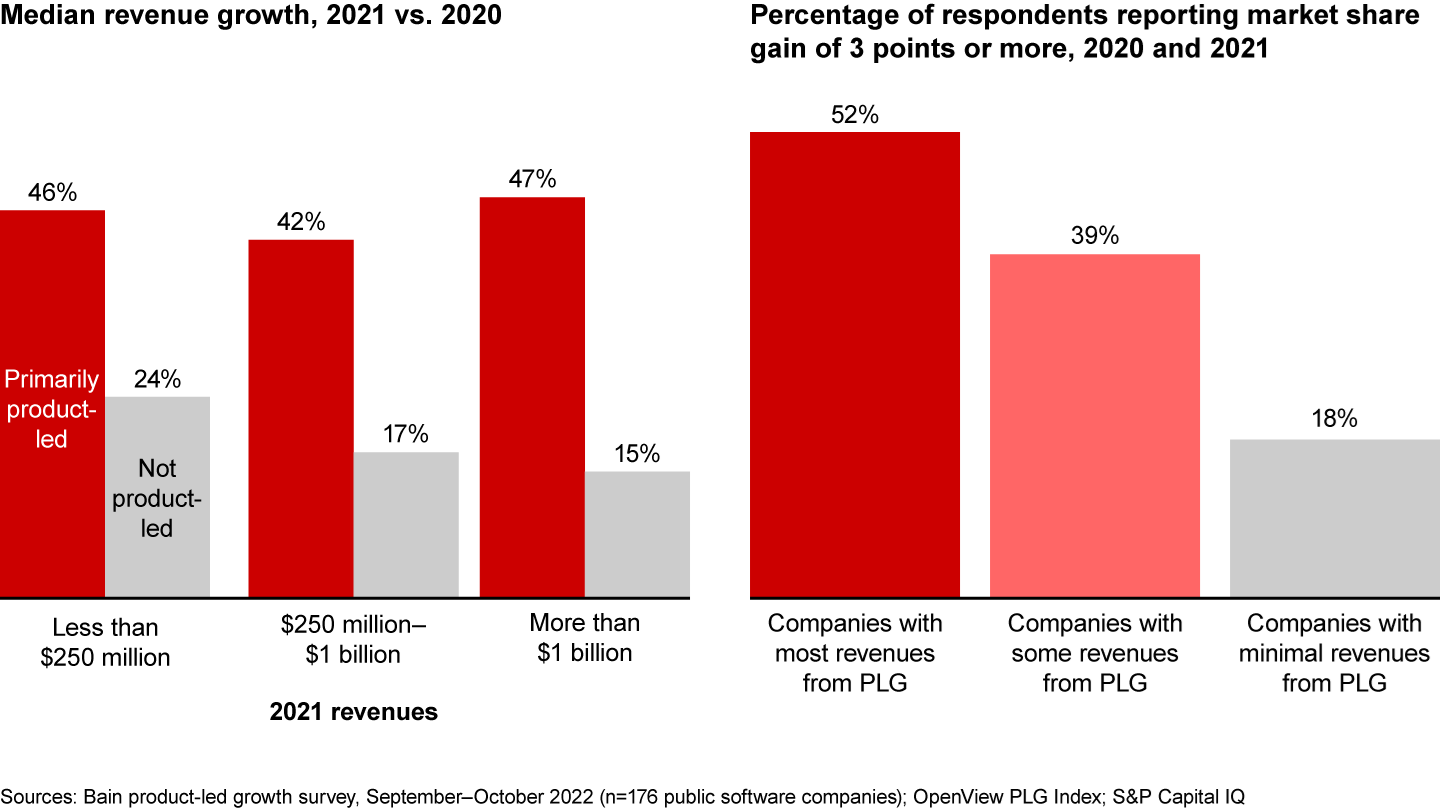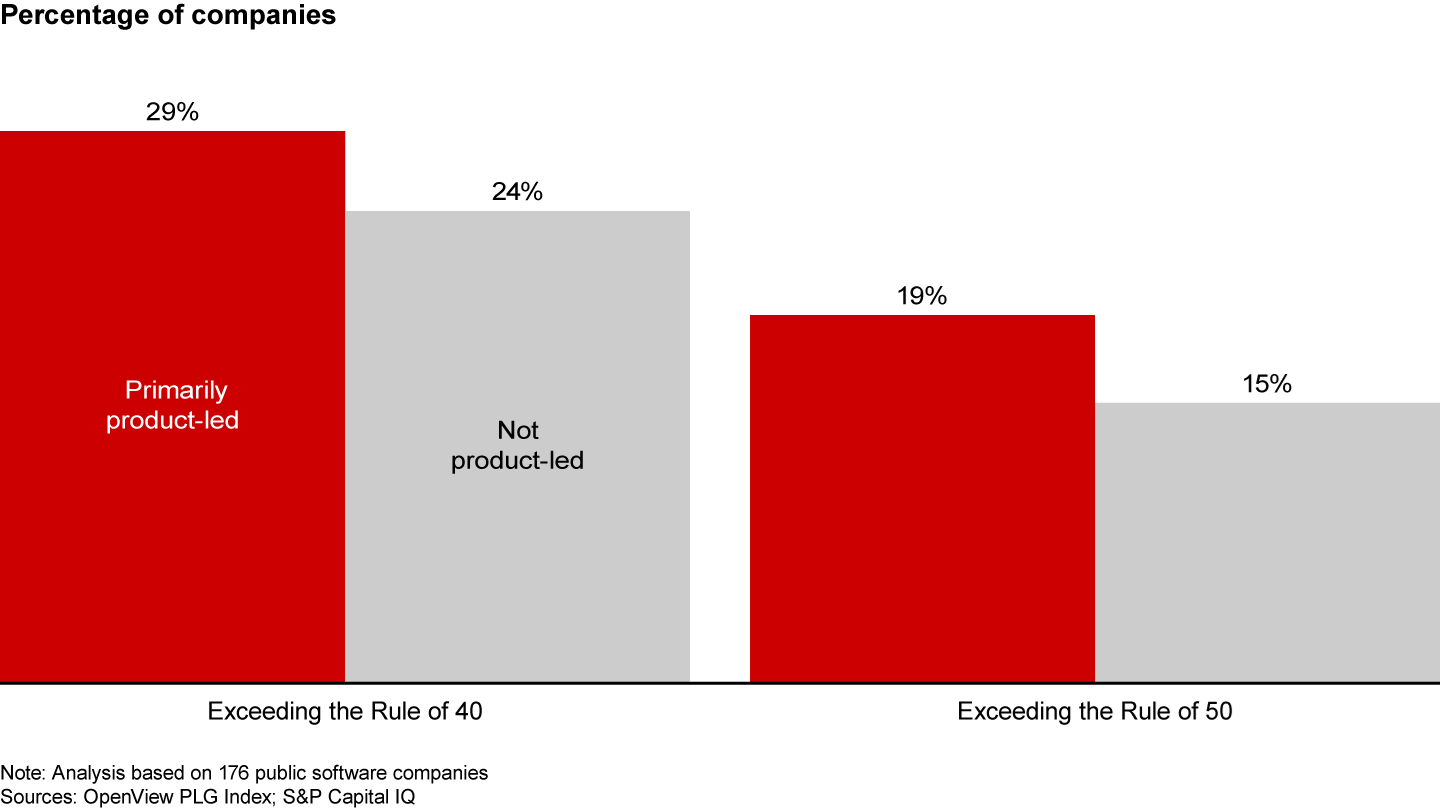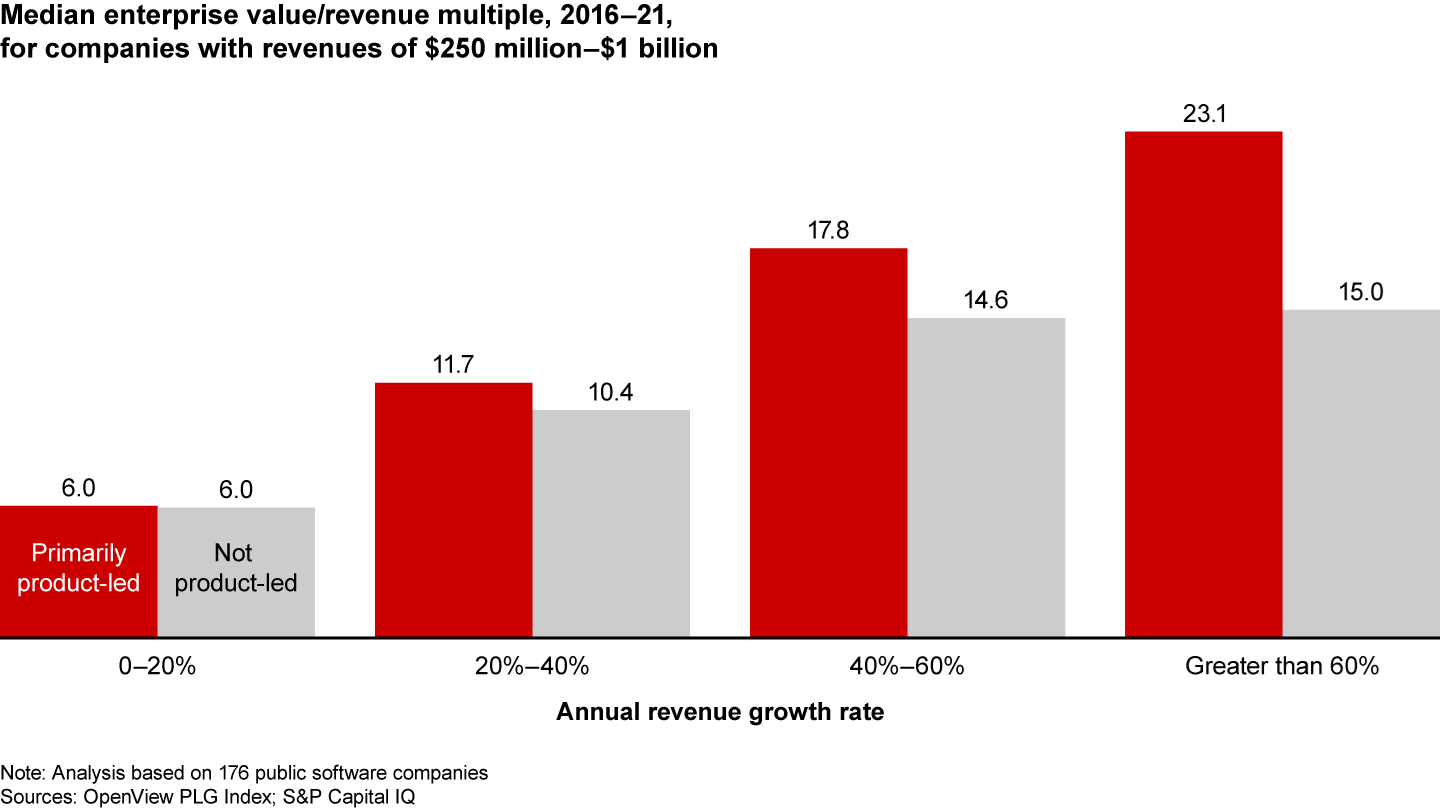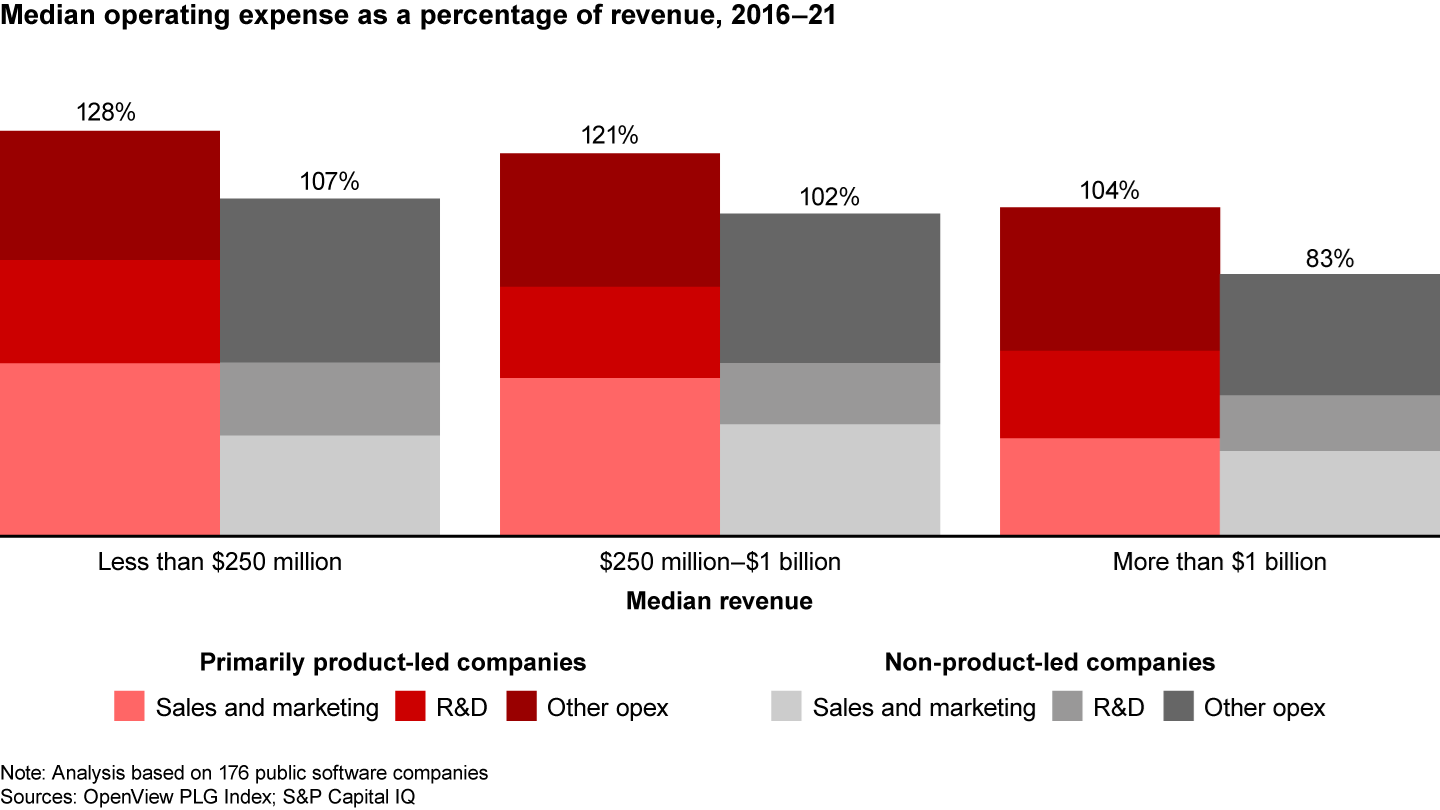Brief

Executive Summary
- Product-led growth, which relies on end users discovering, trying, buying, and scaling up use of a product in a self-serve manner, has caught fire in B2B software markets.
- Bain analysis shows that firms using this model see faster revenue growth, market share gains, and higher valuations.
- However, the shift to product-led growth can be tricky for companies accustomed to leading with their salesforce.
- Getting the transition right requires capabilities across product design, packaging, digital discovery, self-guided education and support, and—surprisingly—enterprise sales to complement self-service.
Six years ago, Dynatrace was in trouble, compared with a rival, Datadog. Its cloud monitoring business faced stiff competition from Datadog, a company using a product-led growth (PLG) strategy. Dynatrace revenue stayed flat from 2017 through 2018 while Datadog’s nearly doubled.
Dynatrace wasn’t the first company to face a PLG disrupter, and it won’t be the last. A recent Bain & Company survey of 176 North American business-to-business software senior executives found that nearly 75% of them are concerned about competition from PLG companies.
The appeal of self-service
PLG has caught fire in software markets, spurred by the success of companies such as Datadog, Atlassian, and Snowflake. Yet many companies still aren’t clear on exactly how it works or how to excel in the strategy, and many underestimate the difficulty of building the requisite capabilities.
PLG focuses on enabling end users to discover, try, buy, and scale up their usage in a self-serve manner, without prompting from a sales team. Companies can apply the model to select products in their portfolio or use some PLG capabilities in a hybrid approach—for example, relying on a sales team for the initial sale, then shifting to PLG self-service for renewals and expansion.
Firms that rely primarily on PLG are growing faster than companies with limited or no PLG focus and are almost three times as likely to have gained market share in recent years (see Figure 1).
A product-led growth strategy produces faster revenue growth and greater market share


This growth leads to strong performance on several important metrics. For example, companies that rely primarily on PLG exceed the Rule of 40 (a combined revenue growth rate and EBITDA margin of at least 40%) and the even more aspirational Rule of 50 at a higher rate than their non-PLG peers (see Figure 2).
Primarily product-led companies exceed the Rule of 40 and Rule of 50 at a higher rate


In addition, investors reward primarily PLG companies with higher valuations, especially at higher revenue growth rates (see Figure 3).
Investors have rewarded primarily product-led companies with higher multiples at comparable revenue growth rates


So how can an individual software company determine whether PLG will fit its product portfolio and organization? The approach works best in markets where automated deployments are possible; end users can make purchasing decisions; the product is sticky, with usage growing over time; and the potential customer base is broad, with lots of free users who can convert to paid.
What it takes
If the market fits, our research suggests that companies must master five capabilities to deliver a strong PLG experience.
Product design. The most important product feature is easy deployment by end users, removing any friction to getting started. For instance, while Datadog’s monitoring and security products are fairly complex, the company says most users see value within one hour. The product should also include triggers and nudges that send upselling and cross-selling messages to users. Further, product telemetry that goes beyond basic usage data is essential for personalization and regular testing.
The good news is that many of these components already serve as best practices for software-as-a-service products. Any gaps, however, require an investment to bridge. “We had to think about how to sell PLG internally to justify the engineering costs,” said one executive we spoke with.
Packaging. The key to effective PLG packaging is a free version that allows users to try before they buy. This could either be a time- or consumption-limited free trial or a feature-limited free tier. While the decision will ultimately depend on a company’s product and market, virtually all PLG-intensive public companies we analyzed have some free version. Regardless of the free experience selected, in-product calls to action should prompt users to upgrade to a higher product tier or consider purchasing additional products.
Pricing should logically scale as users get more value; about 75% of PLG companies surveyed have a consumption-based pricing meter. Unlike the traditional enterprise software model, pricing should be easily calculable from the website to assuage fears about long-term costs. Indeed, more than 90% of PLG companies surveyed have transparent pricing.
Digital discoverability. Since PLG companies rely on user-led product discovery and exploration, they need to drive traffic to their website through search, paid media, communities, influencers, and partners. They focus on end users, rather than traditional corporate buyers, through marketing tactics such as targeted advertising campaigns.
Self-guided education and support. Users who found the product need to see value quickly. About 95% of PLG companies surveyed offered user-driven onboarding through videos and guides. Product learning, from case studies to detailed documentation, should be available to users on the website. As a bonus, these resources improve digital discoverability through search.
In a PLG model, the most valuable source of help is often other users. Company-sponsored or third-party communities such as GitHub give users the chance to learn from each other’s experiences and create buzz. Slack, for example, created multiple channels for education, including a large enthusiast community with local chapters, as well as a Slackbot that guides users through the onboarding process.
Enterprise sales handoff. While PLG is commonly associated with self-service sales, all large PLG companies have enterprise sales teams. Even Atlassian, a famously “no sales” outfit, launched enterprise sales to pursue additional revenue.
As younger PLG companies start to establish an enterprise sales team, they should consider several questions: What is our talent plan? What will our coverage model be? Which accounts should we prioritize? What support will sellers need? How will we integrate enterprise sales with self-service?
Companies coming from a traditional sales-led model have the opposite challenge of integrating the new self-service activities with the existing sales model. This requires clear guidelines for sales engagement, incentives that reflect those guidelines, and updated support, as well as investment in training sellers in a new way of working. The customer success team plays a critical role in a hybrid self-service/enterprise model, as they are often the first point of contact and can take on some traditional sales tasks, such as identifying upsell and cross-sell opportunities.
Building a hybrid model is difficult and requires a lot of time on operational details. Companies should expect some bumps at the start and should support sales staff during the transition. “We guaranteed commission for the first two quarters during the shift to product-led growth so that sellers knew we wouldn’t let them fail,” one sales executive told us.
Investment implications
While some observers believe a PLG strategy means companies can reduce sales and marketing spending to fund research and development, our analysis of public company data shows that primarily PLG companies spend more on both R&D and sales and marketing as a percentage of revenue (see Figure 4).
Product-led growth involves greater spending on operating expenses


This greater investment pays off—product-led companies see more revenue growth for every sales and marketing dollar spent. This growth offsets the profit margin trade-offs from increased investment, which is why PLG companies exceed the Rule of 40 and Rule of 50 at a higher rate than their non-PLG peers. PLG companies that achieve the Rule of 40 do so mainly on growth, unlike non-PLG companies, which rely more on margin.
Dynatrace revisited
Returning to the Dynatrace story, while Datadog remains the PLG leader in its market, Dynatrace has been investing in select PLG capabilities: easy deployment, free trials, scalable pricing, and user-driven onboarding. However, because of constraints from Dynatrace’s pricing model, user buying still goes entirely through the salesforce, and the website does not provide complete pricing details. This could hinder the firm from seeing the growth rates that PLG companies traditionally achieve.
Despite that, adopting select PLG components has paid off. Since 2019, Dynatrace has seen above 25% annualized revenue growth and recently recorded its 15th consecutive quarter with net dollar expansion rates (revenue earned from current customers due to upselling and cross-selling) above 120%.
Leap, but look first
PLG is a major growth opportunity that every B2B software company should consider. The best practices of any transformation still apply: top-down sponsorship from the CEO, recognition that the company will likely need a different operating model, and thoughtful integration with the legacy business.
Software executives can inform their PLG design by addressing some critical questions:
- Which of our products best fit PLG?
- Which key capabilities do we lack that will hold back performance, and what will it take to bolster those capabilities?
- What implications would PLG have on valuation and investments?
- How can we manage the transition to PLG to maximize the upside and limit the risks?
- How can we ensure that our CEO and senior executives commit to this change and investment?
Product-led growth can delight customers, spur faster growth, and command high valuations—if a company applies the approach in the right markets, with the right products and capabilities.